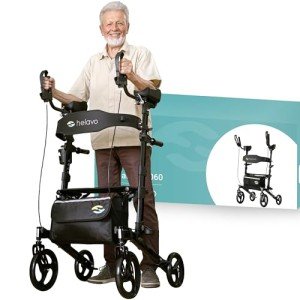Beware Of These "Trends" Concerning Heavy-Duty Walker

The Comprehensive Guide to Heavy-Duty Walkers: Enhancing Mobility and Independence
In an aging society where people are increasingly concentrated on preserving their independence and mobility, heavy-duty walkers have ended up being essential mobility aids. These products offer improved support, stability, and resilience, making them ideal for heavier individuals or those who need extra assistance while walking. In this detailed guide, we will explore the features, benefits, and various types of heavy-duty walkers, aiming to supply a well-rounded understanding for those considering a purchase or those helping someone in need.
What is a Heavy-Duty Walker?
Heavy-duty walkers are particularly developed for individuals needing extra support and stability while walking. Unlike standard walkers, which might have weight limits around 300 pounds, heavy-duty models can accommodate individuals weighing anywhere from 300 to over 500 pounds. They are constructed with stronger materials and include a wider frame for increased stability.
Secret Features of Heavy-Duty Walkers
| Function | Description |
|---|---|
| Weight Capacity | Usually 300-- 500+ pounds, suitable for bigger people. |
| Frame Material | Built from heavy-duty aluminum or steel for strength. |
| Width and Height | Larger frames and adjustable heights for user convenience. |
| Footings | Created with bigger rubber pointers or wheels for enhanced grip and traction. |
| Seats and Accessories | Many designs include padded seats and baskets for benefit. |
Advantages of Using Heavy-Duty Walkers
Heavy-duty walkers provide various benefits beyond easy mobility:
- Enhanced Stability: Their sturdy design prevents tipping and provides a secure base, minimizing the risk of falls.
- Improved Confidence: With the added support, users frequently feel more secure and confident when walking, motivating mobility.
- Personalization: Many heavy-duty walkers have adjustable heights and configurations, catering to the specific needs of users.
- Practical Design: Several models include built-in seats, storage areas, or multipurpose features that make carrying individual products easier.
- Healing Benefits: Regular use of walkers can help enhance blood circulation and promote a more active lifestyle, which is crucial for total health.
Typical Conditions Benefiting from Heavy-Duty Walkers
| Condition | Description |
|---|---|
| Obesity | Extra support for much heavier users requiring assistance with mobility. |
| Arthritis | Provides stability and reduces stress on joints while walking. |
| Post-Surgery Recovery | Assists with rehab and gradual go back to mobility. |
| Neurological Conditions | Supports those with balance or coordination problems. |
| Elderly Mobility Challenges | Uses the elderly a safer means of preserving self-reliance. |
Types of Heavy-Duty Walkers
When selecting a heavy-duty walker, it's crucial to consider the specific needs and lifestyle of the user. Below are the frequently available alternatives:
- Standard Heavy-Duty Walker: Simple yet effective, these walkers feature a robust frame without wheels. Best for static support.
- Rollator Walker: Equipped with wheels, a brake system, and frequently a seat, these walkers aid users in moving at a faster pace while permitting for quick rests.
- Front-Wheeled Walker: This type has 2 wheels at the front and tough legs at the back. hop over to these guys offers more mobility than a basic walker while keeping stability.
- Mix Walker-Transport Chair: These multifunctional devices can be utilized as a walker and quickly converted to a transport chair for those needing more assistance.
- Portable Heavy-Duty Walker: Lightweight but strong, these walkers are developed for ease of transport, perfect for those who travel frequently.
Relative Chart of Heavy-Duty Walkers
| Type | Stability | Maneuverability | Portability | Seat Available |
|---|---|---|---|---|
| Standard Heavy-Duty | High | Low | Low | Optional |
| Rollator | Medium | High | Medium | Yes |
| Front-Wheeled | Medium | Medium | Medium | No |
| Combination Chair | Medium | Low | Low | Yes |
| Portable Heavy-Duty | Medium | High | High | No |
Frequently Asked Questions (FAQs)
Q1: How do I pick the ideal heavy-duty walker for me?
- Weight Capacity: Ensure that the walker exceeds your weight to make sure safety.
- Height: Choose a walker with adjustable height features to fit your body size.
- Usage: Consider your specific needs-- whether you require a seat, extra storage, or the ability to browse various surfaces.
Q2: Are heavy-duty walkers covered by insurance?
Some insurance coverage companies might cover the cost of heavy-duty walkers, specifically if recommended by a healthcare professional. It's vital to talk to your insurance provider for specifics relating to coverage.
Q3: How do I preserve my heavy-duty walker?
Regularly inspect the walker for wear and tear. Tidy the walker's frame and wheels to avoid accumulation. In addition, examine the brakes and adjust the height as needed.
Q4: Can I use a heavy-duty walker on irregular surface?
Some heavy-duty walkers, particularly rollators with larger wheels, are created for different terrains. Nevertheless, standard walkers might not carry out also on uneven surface areas.
Q5: When should I consider utilizing a heavy-duty walker?
If you experience trouble maintaining balance, your weight goes beyond the capacity of basic walkers, or you have mobility limitations due to medical conditions, a heavy-duty walker might be appropriate.
Heavy-duty walkers are essential mobility help that offer many advantages, especially for individuals who need more support. They are essential in promoting independence, security, and confidence while navigating everyday life. By understanding the various types, features, and conditions they can help with, users can make informed decisions in their quest for increased mobility and lifestyle.
For those considering a heavy-duty walker, taking into account personal requirements and preferences will result in a more rewarding and secure walking experience. Whether on your own or a liked one, understanding the complexities of heavy-duty walkers will play an essential role in promoting mobility and independence.

